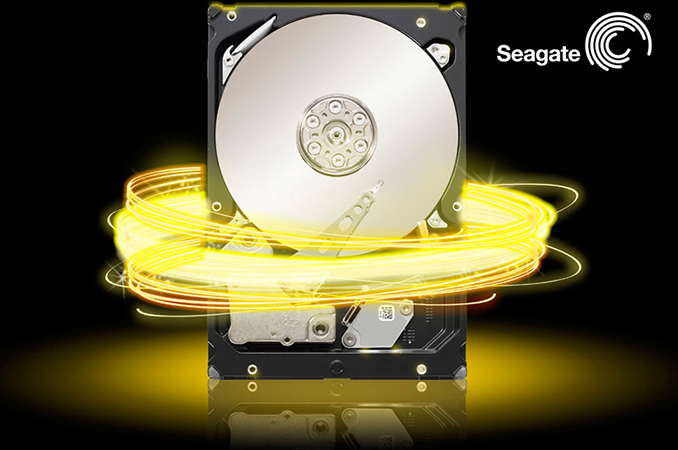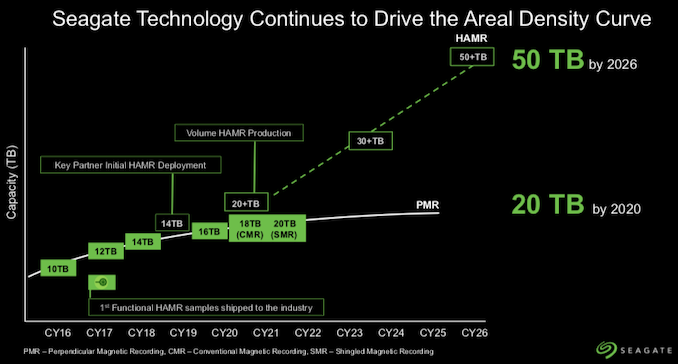Seagate: 18 TB HDD Due in First Half 2020, 20 TB Drive to Ship in Late 2020
by Anton Shilov on November 5, 2019 3:00 PM EST
Seagate last week clarified its high-capacity HDD roadmap during its earnings call with analysts and investors. The company is on track to ship its first commercial HAMR-based hard drives next year, but only in the back half of the year. Before that, Seagate intends to ship its 18 TB HDDs.
It is expected that Seagate’s 18 TB hard drive will be based on the same nine-platter platform that is already used for the company’s Exos 16 TB HDD, which means that it will be relatively easy for the company to kick off mass production of 18 TB hard drives. Overall, Seagate’s HDD roadmap published in September indicates that the company’s 18 TB drive will use conventional magnetic recording (CMR) technology. In addition to this product, Seagate’s plans also include a 20 TB HDD based on shingled magnetic recording (SMR) technology that is due in 2020.
Seagate says that its Exos 16 TB hard drives are very popular among its clients and even expects to ship more than a million of such drives in its ongoing quarter, which ends in December. The launch of its 18 TB HDD will maintain Seagate’s capacity leadership in the first half of next year before Western Digital starts volume shipments of its HAMR+CMR-based 18 TB and HAMR+SMR-based 20 TB hard drives.
Seagate itself will be ready with its HAMR-based 20 TB drive late in 2020. Right now, select Seagate customers are qualifying HAMR-based 16 TB HDDs, so they will likely be ready to deploy 20 TB HAMR drives as soon as they are available. It is noteworthy that Seagate is readying HAMR HDDs with both one and two actuators, as to offer the right performance and capacity for different customers. This would follow Seagate's current dual-actuator MACH.2 drives, which the company started shipping for revenue last quarter.
Dave Mosley, CEO of Seagate, said the following:
“We are preparing to ship 18 TB drives in the first half of calendar year 2020 to maintain our industry capacity leadership. We are also driving areal density leadership with our revolutionary HAMR technology, which enables Seagate to achieve at least 20% areal density CAGR over the next decade. We remain on track to ship 20 TB HAMR drives in late calendar year 2020.
As drive densities increase, multi-actuator technology is required to maintain fast access to data and scale drive capacity without compromising performance. We generated revenue from our MACH.2 dual actuator solutions for the first time in the September quarter. We are working with multiple customers to qualify these drives, including a leading US hyperscale customer, who is qualifying the technology to meet their rigorous service level agreements without having to employ costly hardware upgrades. We expect to see demand for dual actuator technology to increase as customers transition to drive capacities above 20 TB.”
Related Reading:
- State of the Union: Seagate's HAMR Hard Drives, Dual-Actuator Mach2, and 24 TB HDDs on Track
- Seagate Ships 16 TB CMR Hard Drives, Preps 18 TB SMR HDDs
- Seagate Starts to Test 16 TB HAMR Hard Drives
Source: Seagate











35 Comments
View All Comments
shabby - Tuesday, November 5, 2019 - link
Can't wait for the 22tb drive in 2021, whose with me?!?azfacea - Tuesday, November 5, 2019 - link
the issue is not max capacity. the issue is TB per dollar. HDD have been quite stagnant since 2010 and will do even worse in 2021 with the miniscule volume they will be left with by then.close - Wednesday, November 6, 2019 - link
azfacea singing the death song to hard drives. Again. About that TB/$, doesn't really show it flatlining as you suggest: https://www.backblaze.com/blog/hard-drive-cost-per...Maybe Backblaze doesn't have access to the same high quality data you have.
Other random links showing a drop which percentage wise is pretty consistent (~50% from 2010, even if in absolute numbers it's low):
https://jcmit.net/diskprice.htm
https://mkomo.com/cost-per-gigabyte-update
azfacea - Wednesday, November 6, 2019 - link
"azfacea singing the death song to hard drives. Again" i didnt know i needed your permission.cant deal with the argument attack the person. NT
50% drop since 2010. and what happened since 2000 to 2010 was that 50% as well ?
u just proved my point, half a node progress in one decade. oh wow hard drives are so alive they are so on fire oh wow
close - Thursday, November 7, 2019 - link
Don't move the goalpost, I thought prices absolutely stagnated since 2010. Now you wanna talk about 2000? Nice way to concede the point ;).ballsystemlord - Wednesday, November 6, 2019 - link
All of the links point to the price of <=4TB drives falling. >4TB prices are higher per TB and there's not much information on whether or not they continue to fall in price in 2019.In particular, try looking at >=10TB models. I've watched them like a hawk in the past year. They're still very very expensive.
The deals make them nicer in some cases, but we're talking regular pricing.
close - Thursday, November 7, 2019 - link
Roses are red, violets are blue, we were talking about prices for hard drives not stagnating since 2010 but going down, and your comment that you "very thoroughly" substantiate above does nothing to contradict my argument. I suck at rhymes but I do know how to make a valid point ;).dudadiesel - Sunday, November 17, 2019 - link
I've noticed price per TB has finally started to come down as I picked up 16 TB drives compared to my last buy of 8 TB drives. It really was stagnant for a while. I'm curious to see how the pricing for HAMR based HDDs pans out. I won't be jumping onto them because of potential reliability issues (want to wait a few years and see how they do) and I'm sure the price will be pretty bad at the start. Meanwhile, they're kicking out more releases of the existing technology just to soak in the money from releasing slowly instead of just jumping to the greatest capacity that they can do. Ok, they do need to test them as they go and maybe if they go right to the max it'll turn out to be a failure and can't be released.One worry I have about enormous spinning drives is the ability to back them up. 50 TB at even the actual max speed of 12 Gbps (SAS) would take ~5 days to copy. If a drive fails in a RAID system that's a little unnerving to know it takes that long for the only remaining drive in a single mirror array to copy its contents. I think we're going to enter a time when we have to make several mirrors of data just to keep up with reliability. Thankfully, drives don't die much these days but that goes back to my comment about HAMR and not knowing just how well it's going to hold up.
Ultimately, having high capacity drives helps drive down electrical costs to operate less capacity drives but up goes risk so it's difficult to decide which way is best.
As for consumers using spinning drives, yes, there's a lot less demand for them. Consumers are mostly interested in performance and put their reliance on backup to the clouds these days. But spinning drives are going to be around for a very long time on those servers holding all of this massive data. It's still questionable as to whether SSD will ever overtake spinning drives. We may end up with a new medium which blows both of them away before HDDs are finally retired. SSDs are so fragile that I'm weary of storing important stuff on them.
trparky - Tuesday, November 5, 2019 - link
You know what they say about large hard drives right? The larger they are the longer you're going to cry when it dies and it takes your data with it.Flunk - Tuesday, November 5, 2019 - link
It's a shame that backing up data is impossible.